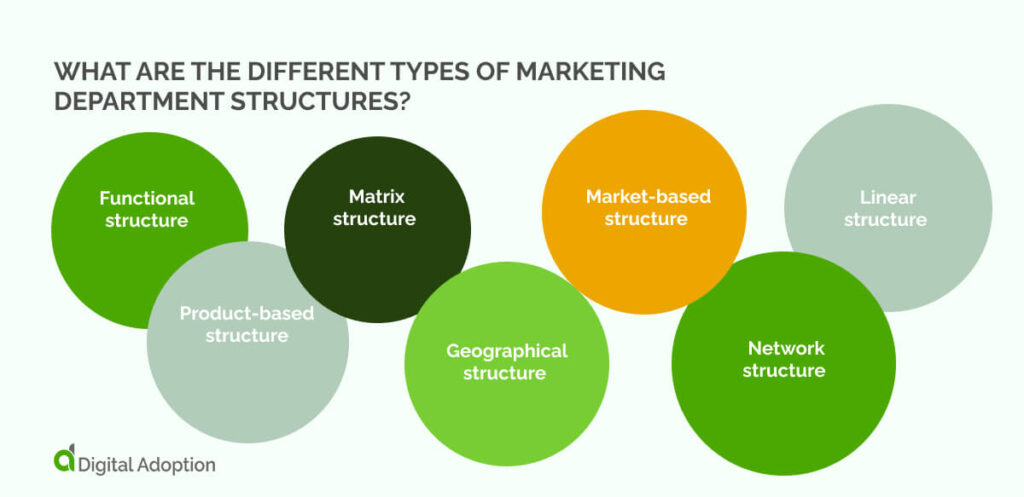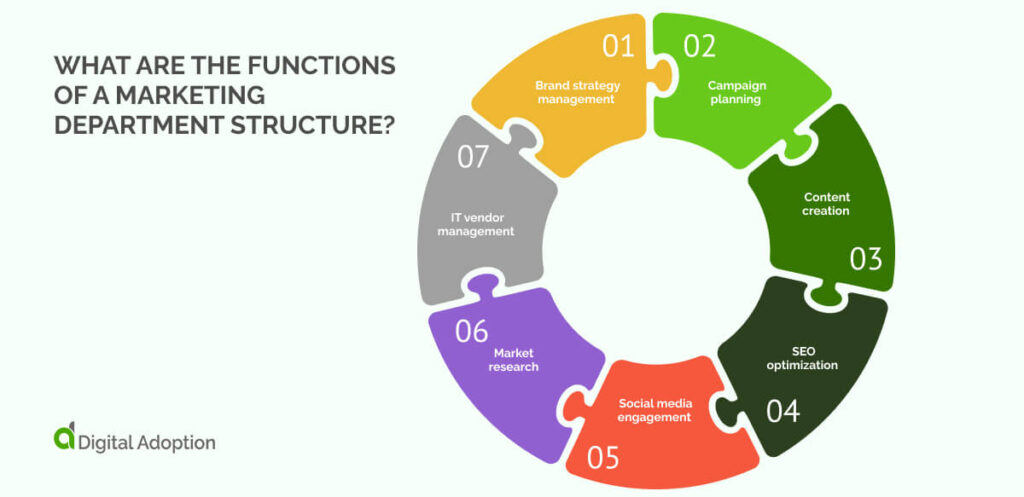As AI continues to reshape industries, marketing stands out as a key area driving innovation. The adoption of AI tools and data-driven insights is fueling growth, with marketing jobs projected to increase by 6% by 2032.
Despite this growth, marketing budgets often face scrutiny, making it essential for departments to allocate resources effectively.
To stay competitive, marketing teams need a department structure that can quickly adapt to technological changes and capitalize on new opportunities.
This article will examine modern marketing department structures, discussing different types, key roles, and functions within marketing teams. We’ll also provide guidance on building a structure that aligns with your business’s size and industry needs.
- What is a marketing department structure?
- What are the different types of marketing department structures?
- What are the different roles in a marketing department structure?
- What are the functions of a marketing department structure?
- How to build a marketing department structure
- Tailoring your marketing department structure for success
- People Also Ask
What is a marketing department structure?
A marketing department structure is a framework for how a company organizes its marketing team, including the chain of command, employee roles, and goals.
Marketing department structures depend on the type, size, and industry of the business. Companies need a marketing department that meets their goals. This lets teams adjust to market trends and customer needs.
What are the different types of marketing department structures?

As new technologies emerge, marketing departments must be flexible. Different marketing department structures exist, each tailored to specific business needs.
Understanding these helps marketers pick effective strategies. It’s also important to review your approach to keep up with changes.
Let’s take a look at the marketing department structures that most businesses use:
Functional structure
Most businesses use a functional marketing department structure. This setup groups teams by their skills. Special teams handle tasks like content creation, PR, SEO, and paid advertising. It helps meet marketing goals and encourages new ideas.
Advantages
- Specialization
- Clear career paths
- Efficient execution
Disadvantages
- Possible silos
- Reduced teamwork
- Slower campaigns
Product-based structure
A product-based structure organizes marketing teams’ by-products. Each team promotes and sells one specific product. This setup allows for marketing strategies that match product goals and meet customer continuity needs.
Advantages
- Focus on one product
- Clear goals
- Quick help for customers
Disadvantages
- Teams may work alone
- Less brand focus
- Competition for resources
Matrix structure
The matrix structure combines functional teams with project teams. Employees report to both a functional and a project manager, which encourages teamwork across departments, enhances communication, and allows for quicker responses to changes.
Advantages
- Better teamwork
- Learn different skills
- Fast changes
Disadvantages
- Confusion with two bosses
- Clashing priorities
- Stress for workers
Geographical structure
In a geographical structure, marketing teams are organized by location. Each team focuses on its area’s needs. This setup helps companies create marketing strategies that match local cultures and preferences, making reaching regional customers more effective.
Advantages
- Local strategies
- Understanding customers
- Effective regional marketing
Disadvantages
- Mixed brand messages
- Duplicate resources
- Communication challenges
Market-based structure
A market-based structure organizes marketing teams by customer groups. Each team makes marketing strategies for its audience. This setup improves focus on customer needs and helps businesses respond quickly to market changes.
Advantages
- Customer focus
- Quick responses
- Expertise in target audiences
Disadvantages
- Neglecting other customers
- Competition between teams
- High research needs
Network structure
The network structure relies on partnerships with outside organizations. Marketing teams work with other companies and freelancers to reach their goals. This model is flexible and gives access to different skills. It helps businesses quickly grow when needed.
Advantages
- Flexible to change
- Access to skills
- Quick growth
Disadvantages
- Depend on others
- Hard to talk to many people
- Variable quality control
Linear structure
A linear structure has a clear chain of command. Teams report to one manager who oversees their work. This design makes communication easy and decisions straightforward. However, its strict organization can limit flexibility and creativity.
Advantages
- Clear communication
- Simple decisions
- Defined team roles
Disadvantages
- Limited flexibility
- Stifled creativity
- Resistance to change
What are the different roles in a marketing department structure?
A marketing department has many important roles. As technology changes, new roles are created, and some evolve.
Understanding each role and its duties is vital. This clarity helps ensure everyone is accountable and aligned with marketing goals.
Let’s explore the different roles in a marketing department:
- Chief marketing officer (CMO): A CMO leads the marketing team. They create strategies to grow the brand and make sure the team meets its goals.
- Marketing strategist: A marketing strategist plans how to reach business goals. They study markets and audiences to create strategies that help the team succeed.
- Account manager: An account manager connects with clients. This role involves building strong relationships and ensuring clients are happy with their projects.
- Project manager: A project manager leads marketing projects. They organize the team and set deadlines to ensure timely completion.
- Data analyst: A data analyst looks at data to find trends. This helps the team see what works well and what needs to be improved in their marketing efforts.
- Content marketing specialist: A content marketing specialist makes plans for content. They focus on engaging the audience and driving traffic to the website with effective messages.
- SEO specialist: An SEO specialist improves a website’s ranking on search engines. They optimize content and use keywords so more people can find the brand online.
- Social media specialist: A social media specialist takes care of the brand’s social media accounts. They create posts and interact with followers to build community and engagement.
- Paid specialist: A paid specialist runs advertising campaigns to attract customers. They manage budgets and track results to ensure a good return on investment.
- Conversion rate optimization specialist (CRO): A CRO specialist works to increase website conversions. They study user behavior and suggest changes that improve the user experience.
- Affiliate specialist: An affiliate specialist builds partnerships with affiliates, tracks performance, and helps affiliates boost sales through their efforts.
- Influencer specialist: An influencer specialist works with social media influencers. They create campaigns to promote the brand and reach more people.
- Graphic designer: A graphic designer makes visuals for marketing materials. They ensure that all designs match the brand’s style and clearly communicate the message.
- Videographer: A videographer creates videos for marketing campaigns. They handle everything from filming to editing, making content that engages the audience.
What are the functions of a marketing department structure?

Marketing departments are often large and have many important functions. Understanding these functions is key to creating a strong structure.
Specific roles help the department run smoothly. It makes things easier to understand and supports better decisions.
Let’s take a look at the most common functions of a sales department structure:
Brand strategy management
Brand strategy and management focus on building a brand’s identity. This means deciding what the brand stands for and how it looks. Good brand management creates customer loyalty. It helps the brand stand out and meet business goals.
Campaign planning
Campaign planning involves creating marketing campaigns. This includes setting goals and picking target audiences. Teams also choose how to communicate. Good planning ensures that campaigns run well and meet deadlines. A strong campaign increases digital engagement and sales.
Content creation
Content creation means making valuable content. This includes writing articles, making videos, and creating graphics. Teams share this content on different platforms to reach people. Good content builds trust and gets customers interested in the brand.
SEO optimization
SEO optimization helps improve a website’s appearance on search engines. This includes finding the right keywords and improving content. Teams also make the website easier to use. Good SEO brings more visitors, and a better website helps increase sales.
Social media engagement
Social media engagement means talking to customers on social media. Teams create posts and reply to comments. Engaging with followers builds community and loyalty. It also gives feedback. This helps the marketing team understand what customers want.
Market research
Market research involves gathering information about customers and competitors. Teams use data to understand what is happening in the market. This helps find opportunities and challenges and create better marketing strategies.
IT vendor management
IT vendor management means working with outside partners on digital solutions. This includes negotiating deals and reviewing processes. Vendor management ensures the results are high-quality and completed on time. Strong partnerships help obtain the resources needed for successful marketing.
How to build a marketing department structure
Building a marketing department structure can be tricky. It requires careful planning and a lot of knowledge. You must also understand your business’s goals and the roles needed to achieve them.
We will explore how to create an effective marketing department structure for businesses of different sizes.
Let’s look at some specific strategies for small, medium, and large companies:
Small business
Small-sized businesses should focus on the following:
Multifunctional roles
Small businesses should hire team members who can handle multiple jobs. For example, one person might manage social media and create content. This flexibility helps the team respond quickly to different needs.
Lean and agile methods
Using lean and agile processes is important. Keeping tasks simple and being ready to adapt helps small businesses stay efficient. Changes based on customer feedback can make marketing more effective.
Digital-first approach
Small businesses should focus on digital marketing. They can use social media, websites, and email to reach customers. This approach helps them connect with more people while saving money on marketing costs.
Medium business
Medium-sized businesses should focus on the following:
Specialized tasks
Medium businesses do better when they have specific roles for different marketing tasks. For example, hiring an SEO expert and a social media specialist can lead to better results. Each person can focus on what they do best.
Content focus
A good content and inbound marketing strategy is very important. Creating helpful content attracts customers and builds trust. When people find useful information, they are more likely to connect with the brand and make purchases.
Channel integration
Ensuring all marketing channels work together is essential. Marketing messages on social media, email, and websites should match. This consistency helps create a seamless customer experience, making them more likely to connect with the brand.
Large business
Large-sized businesses should focus on the following:
Matrix structure
Large businesses should consider a matrix structure for their marketing teams. Organizing teams by product and function helps improve collaboration. Everyone can work together while staying focused on their specific goals.
Brand divisions
Establishing divisions for each brand or product line is useful. This setup allows teams to create targeted marketing plans that speak directly to their audience. Focusing on specific products attracts more customers and increases user adoption.
Marketing tech stack
Investing in advanced marketing technology is crucial for large businesses. Tools for data analysis and automation can streamline marketing efforts, allowing teams to work more efficiently and make informed decisions.
Tailoring your marketing department structure for success
Selecting the right marketing department structure is crucial.
Whether your chosen structure is functional, matrix, or network, it should reflect the size of your company, mission, and focus.
Your department’s roles and functions, from brand managers to content specialists, must work together to achieve marketing goals. The CMO needs to be able to measure the performance and contributions of all of those roles.
Conduct annual assessments of your marketing department structure to maintain your competitive edge. This will ensure your department stays aligned with the latest technologies and marketing changes.
Your brand’s identity should be as fluid as the market. This means your marketing structure should move with it and find flexibilities to optimize your brand’s perceptions and customer satisfaction.
People Also Ask
-
What is a marketing department?A marketing department is a team in a company that promotes products or services. They create ads, manage social media, and connect with customers. They aim to attract people to the brand and help the company grow.
-
How do you run a successful marketing department?To run a successful marketing department, set clear goals and roles for team members. Use data to understand what customers want. Communicate well within the team and adjust strategies based on feedback. Regularly review results to improve future efforts.
-
What is the purpose of the marketing department?The marketing department promotes the company’s products or services. It aims to reach and attract customers, build brand awareness, and drive sales. This helps the company grow and succeed in a competitive market.













